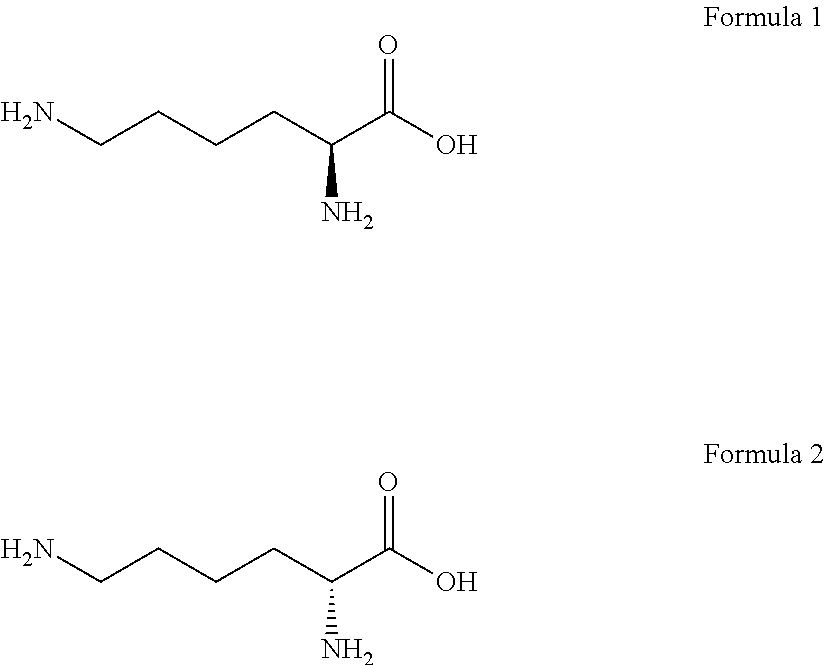Adhesive composition and preparation method therefor
- Summary
- Abstract
- Description
- Claims
- Application Information
AI Technical Summary
Benefits of technology
Problems solved by technology
Method used
Image
Examples
example 1
Evaluation of Stability of Composition Including Lysine and Various Organic Acids
[0090]Lysine, as a basic amino acid, and various organic acids were mixed to prepare compositions. Stability of each composition (whether precipitates were formed) was evaluated.
[0091]Method of Preparing Adhesive Composition Including Lysine and Malic acid:
[0092]107.6 g of distilled water (DIVV) was added to 100 g of a 61.5 wt % aqueous solution of L-lysine free form and the mixture was stirred at room temperature (25° C.) for 30 minutes to dilute lysine. 84.61 g of malic acid (MA, DL-malic acid) was slowly added to the diluted lysine while stirring at room temperature (25° C.) for 1 hour, and then the mixture was stirred at room temperature (RT) for 1 hour. Subsequently, after the reaction mixture was cooled to room temperature (25° C.), the reaction was terminated to obtain 292.21 g of an adhesive composition. A solid content of this composition was about 50 parts by weight based on 100 parts by weigh...
example 2
Evaluation of Solubility According to Solvent of Composition
[0096]Adhesive compositions including lysine and malic acid were prepared in the same manner as in Example 1 (molar ratio of lysine to malic acid=1:1.5 and solid content: 50 parts by weight). 25 g of an additional solvent shown in Table 3 below was added to 50 g of each of the prepared adhesive compositions and the mixture was stirred for 1 hour. After stirring, solubility of the adhesive composition to each solvent was identified. Types of the added solvent and evaluation results of solubility of the adhesive composition to each solvent are shown in Table 3 below.
TABLE 3No.Additional solventDissolution results2-1Methanoldissolved2-2Toluenenot dissolved2-3Benzenenot dissolved2-4Chloroformnot dissolved2-5Methylene chloridenot dissolved2-6Dichloromethanenot dissolved2-7Tetrahydrofuran (THF)not dissolved2-8Ethyl acetatenot dissolved2-9Dimethyl formamide (DMF)not dissolved 2-10Dimethyl sulfoxide (DMSO)not dissolved 2-11n-hexane...
example 3
Analysis of State, Viscosity, and Initial Tack of Adhesive Composition According to Mixing Molar Ratio of Lysine to Malic Acid
[0098]Stability, viscosity, and initial tack of adhesive compositions of the present disclosure according to the molar ratio of lysine to malic acid included in the adhesive compositions were analyzed.
[0099]Adhesive compositions including lysine and malic acid were prepared in the same manner as in Example 1, except that molar ratios of lysine to malic acid were adjusted to 3:1, 2.5:1, 2:1, 1.5:1, 1:1, 1:1.5, 1:2, 1:2.5, and 1:3, respectively (where the solid content was 50 parts by weight).
[0100](1) Evaluation of Stability
[0101]Stability of the adhesive compositions having various molar ratios was evaluated according to the following method. About 1 g of each of the adhesive compositions was applied to an aluminum dish having a diameter of 5 cm. Then, formation of precipitates was identified in the adhesive composition under the following drying conditions.
[...
PUM
| Property | Measurement | Unit |
|---|---|---|
| Temperature | aaaaa | aaaaa |
| Temperature | aaaaa | aaaaa |
| Percent by mass | aaaaa | aaaaa |
Abstract
Description
Claims
Application Information
 Login to View More
Login to View More - R&D
- Intellectual Property
- Life Sciences
- Materials
- Tech Scout
- Unparalleled Data Quality
- Higher Quality Content
- 60% Fewer Hallucinations
Browse by: Latest US Patents, China's latest patents, Technical Efficacy Thesaurus, Application Domain, Technology Topic, Popular Technical Reports.
© 2025 PatSnap. All rights reserved.Legal|Privacy policy|Modern Slavery Act Transparency Statement|Sitemap|About US| Contact US: help@patsnap.com


